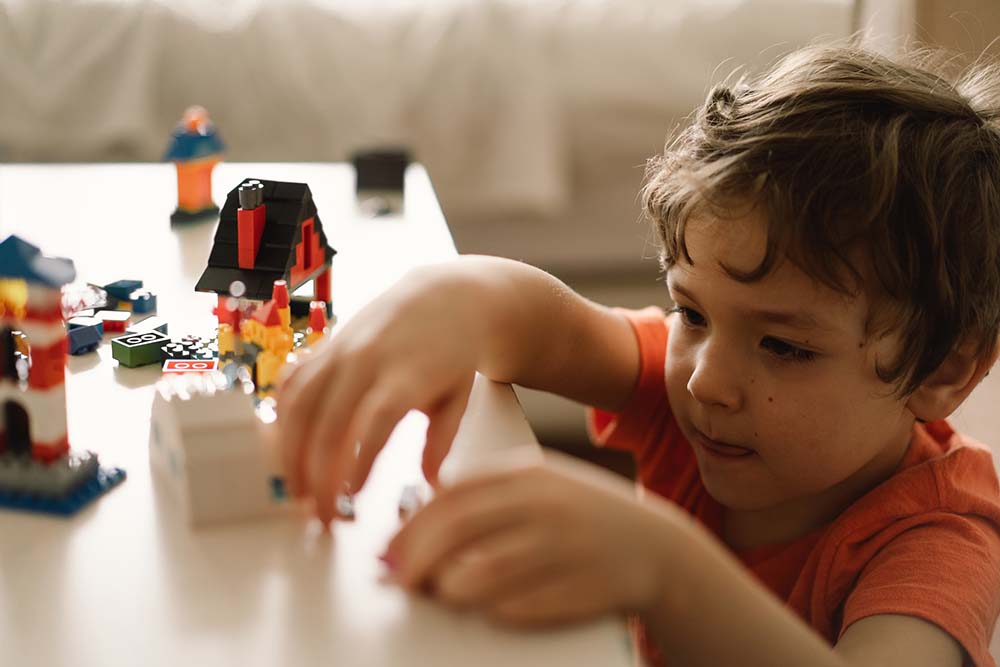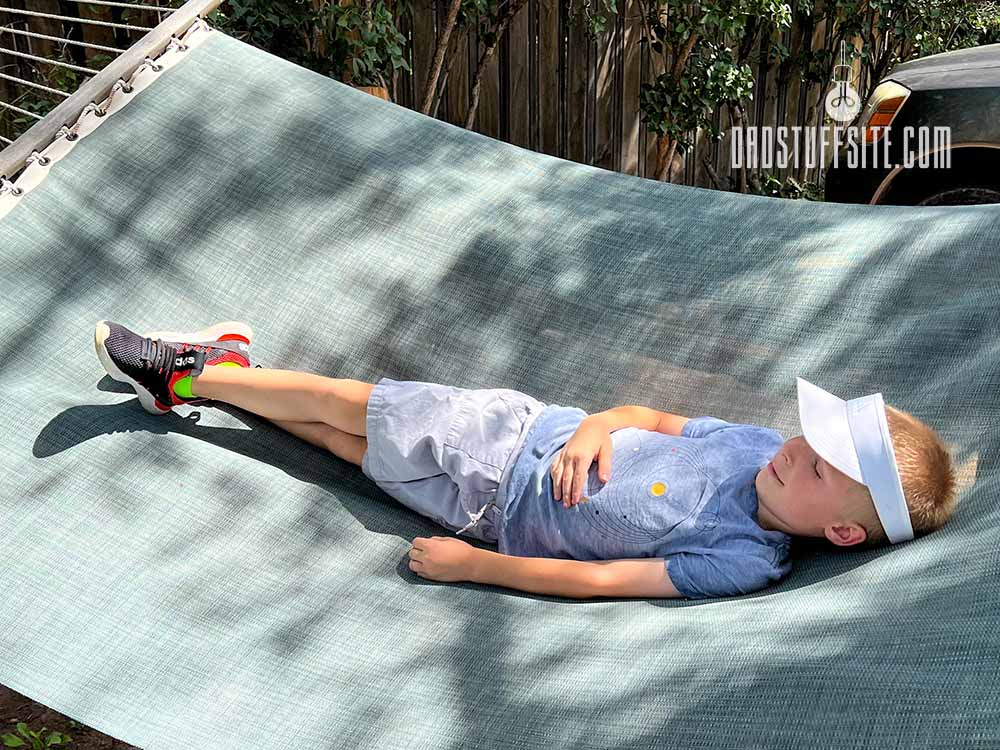
We’ve all been there. The kids are home from school and complain they’re bored. While I’m all for coming up with ways to keep your kids busy (I made a whole website on the subject), this is also a teachable moment.
For starters, as tempting as it is, don’t instantly turn to screen time. We as parents need to teach our kids to cope with boredom. Instead of giving in to the smartphone, let’s teach our kids how to confront their own boredom and teach them to find their own solutions.
There are many studies out there regarding the mental and physical health risks regarding too much screen time. Check out this article from New York-Presbyterian for more: What Does Too Much Screen Time Do to Children’s Brains?)

Boredom is not a disease. Sometimes we all get a little stuck in a rut though. We need to teach our kids some strategies for coping with boredom. Once you get your kids started on an activity they’ll usually run with it.
Help your kids find the things they’re interested in. Some kids are more interested in reading and learning while others like playing games and doing things with their hands. Once you help your kids discover their interests, figure out some short and long-term activities they can turn to when they’re bored.
Here’s my personal mantra I tell my kids when they complain about being bored: Read Something, Do Something, Learn Something, Make Something, or Rest. If they’re still stuck, then they need to pick (and must participate in) an activity from the Boredom Jar.
1. Read Something
Unfortunately for many kids, reading is associated with school and homework. But reading (especially when coping with boredom), doesn’t have to mean reading and writing a book report on War and Peace. A comic book is always an acceptable reading option (some of my kids’ favorites are Garfield and Calvin and Hobbes).

Help your kids discover the kinds of books they like. Kids are people too (so easy to forget sometimes) and like adults, have preferences. Some kids like fiction, others non-fiction. Work with your kids to help them discover the genres they enjoy reading and then find the authors and subjects they interested in.
Take a trip to the local library and bring home a good assortment of books. If you’re unfamiliar with the library, talk to the librarian of the children’s section. They know many trends and can help you pick out age-appropriate books on subjects your child might find interesting.
Get a book or two from a series, some comics, graphic novels, and how-to books. It’s okay to turn to a chapter book at certain times of the day and a comic at other times. Once you get a kid interested in a good story (and get over the homework-like stigma), they’ll devour the rest.
This is by no means an extensive list, but here are some chapter books series and graphic novels to get started:
Chapter Book Series:
- Harry Potter (who doesn’t love HP?)
- Percy Jackson and the Olympians
- Wings of Fire (an personal favorite of my oldest right now)
- Anne of Green Gables (my wife’s all time favorite series)
- Diary of a Wimpy Kid (a good early chapter book series)
- The Chronicles of Narnia (classic)
- The I Survived Series (This historical fiction series tells stories of major events in history from the perspective of a kid that lived to tell the story. Also available as a graphic novel.)
Graphic Novels:
- Zita the Space Girl
- Mighty Jack (a spin-off from Zita)
- Dog Man
- Cat Kid Comic Club (a spin-off from Dogman)
- The Invesitgators (a current favorite of my youngest)
- Press Start (the Super Rabbit Boy series)
- Plants vs. Zombies

While you’re at the library, get a book or two for yourself. Take some time and read yourself. Make sure the kids see it. Read together. Take your new books and go to a coffee shop. Show them that reading is enjoyable for you too (even if you need to remind yourself that you like reading). Before you know it, reading will be a whole family experience.
2. Do Something
My oldest son is a major introvert and has no problem turning to books when he’s bored (almost to a fault). My youngest son loves to be active and interact with people. When he complains about being bored, I help him to find something to do.
This really could be almost anything. They can play a game, a sport, build Legos, or whatever they’re interested in. When you talk to your kid, don’t leave it there. You need to do a bit of investigating and understand your child a little more. Do they prefer to be more physical with their activities? Do they just want to interact with other people? Give some suggestions to get them started, but steer them in a direction they’re interested in and fits their personality.
For board game ideas, check out 30 Old-School Games Your Kids Will Love (with Commercials!).

If you have a child that rejects every idea you offer, it’s usually because they’re seeking your attention. I find it helpful to give two or three ideas they need to choose from. I usually include as one of the offerings to help me with whatever task I’m doing. Don’t undersell it or try to make it sound boring. Genuinely invite them to help you out.
One of two things usually happens. Either they’re mortified with the idea of working they choose the other activity, or they help. If it’s a bigger job, offer to pay them for their work (it’s not a bad lesson to teach kids that money is associated with hard work).
3. Make Something
If you have a kid that likes to create, this is a great option. They can make anything from writing a story, to creating art, to STEM, to cooking. Once again, we need to do some investigating and get to know our kid’s interests.
Does your child enjoy cooking? Encourage them to make some cookies (I find baking is great for starter cooking projects). Are you bored too? Why not work together to make a menu for tonight’s dinner and work together to cook it? You can even watch an episode of a cooking show for inspiration (my kids and I love Alton Brown’s Good Eats).
If you’re looking for some art activities, you can be as elaborate as making an Iron Man helmet, or keep it simple and sketch in a notebook. Either way, YouTube is a great resource. Art for Kids is a great channel with lots of drawing tutorials. If they want to make it more elaborate, cut out their creations and turn them into a stop-motion video.
If your kids are more science/engineering minded, get a rocket kit from your local hobby store. While you’re at it, order Mike Westerfield’s Make: Rockets: Down-to-Earth Rocket Science (which has great activities for low-powered rocketry, air-powered rockets, and water rockets. A great book with a ton of information).
For more on getting into rockets, check out Model Rockets with Kids (What to Get and Where to Launch).
4. Learn Something
Too often kids turn learning into a four-letter word. It’s that thing kids are forced to do in school, a sadistic activity that teachers make kids endure. It wasn’t until I was much older that I realized how much I love learning new things.
Give your kids the option to learn a new skill or develop an old one (admittedly, this might include some technology, but time on Duolingo is not the same as Angry Birds). This could include basic coding, working on a foreign language, learning about nature, or about other cultures.
Teach your kids some secret codes and ciphers (check out 6 Secret Codes and Ciphers to Teach Young Kids for some ideas). Not only are they learning something new, but this can quickly turn into a game of spies as your kids send each other secret messages.

Sites like Code.org teach fundamental skills related to coding to kids as early as kindergarten. If you’re looking for something more hands-on, check out 30 Days Lost in Space by Inventr.io. This kit comes with electronic components and an Arduino board. Instead of a basic how-to, you have 30 lessons in coding and microelectronics. The kit follows a 30-day narrative in which you must repair your space shuttle and return to Earth.
If you’re looking for STEM ideas, my kids LOVE Mark Rober’s Crunch Labs (this is not an affiliate). Mark manages to create projects kids can build that they actually like playing with past the initial novelty. Each project comes with a longer YouTube video explaining an engineering concept.
The publishers at Make Magazine have published some fantastic STEM-related books. Some books are more for older kids (5th grade and beyond) and might need parental help like Make: Electronics (I still keep returning to this as an adult). Some great books for younger kids include Make: Electricity for Young Makers and Make: Tech DIY: Easy Electronics Projects for Parents and Kids.
Every summer we have a family challenge to learn a foreign language. You can either choose a language and immerse yourself as a family or let each child choose their own. Duolingo is a free option or if you decide to get serious, check out Rosetta Stone (this is not an affiliate). Listen to music from that culture and try to find a documentary about the country.

5. Rest
Sometimes your kids are just tired and don’t want to admit it. When your kids were younger they needed at least one nap a day. At some point, they outgrew it (or at least they think they did). Let’s be honest, even as adults, we need a nap now and again. Considering their growing bodies and brains, sometimes your kids need a little rest.
Related: 3 Ways to Play with Your Kids (While Sitting on the Couch)
This could mean taking a nap on the couch or a hammock outside. And sometimes it means just turning off your brain for a bit and taking a break (without screen time. Let’s be honest. Are you really recharged after a 30-minute doom scroll through Instagram Reels?). Encourage them to take a walk and listen to music or an audiobook. Take a chair outside, get some fresh air and some vitamin D, and people-watch.

Encourage your kids to take a moment to still their minds and bodies. Whether you sleep or not doesn’t matter as much as learning to take a couple of minutes to recharge your body and mind. And while they’re at it, bring a fun drink and take a break with them.
6. Boredom Jar
When all else fails, turn to the Boredom Jar. This is a container filled with little pieces of paper with an activity written on each piece. Each activity should be something they can do right now. You should not need to go to the store to get anything, and you should not need to wait for it to happen (like going to the local planetarium that’s only open on the weekends).
Activities can include bottle flipping like Dude Perfect, building a house of cards, laying out dominos to knock over, or tattooing a banana.
To learn more, check out The Boredom Jar: 30 Activities for When Your Kids are Bored
There is one big rule when turning to the Boredom Jar. You must honor the activity that is drawn from the Boredom Jar. There is no, “I don’t feel like doing that,” option when you choose from the jar. This is to avoid continuously choosing items from the jar (and losing the element of mystery).
The idea is that we help our kids learn to choose an activity themselves. We’re trying to teach them a coping skill, so in the future when they inevitably are bored again, they can turn to the mantra of, “Read Something, Do Something, Learn Something, Make Something, or Rest,” and find a solution themself. If, and only if, they’re stuck, then we turn to the Boredom Jar to decide for us.
Related Posts
I love my kids. I really do. But sometimes I get tired of dealing with complaints of, "Daaaad, I'm bored!". I'm all for helping them out when I can, and I think there is value in them learning how to...
A couple of years ago, I had the opportunity to spend a month with my family in Santa Fe, NM. We were traveling for my wife's work, and I had the summer "off" (I'm a college professor). I was...
